Uncorking Cava!
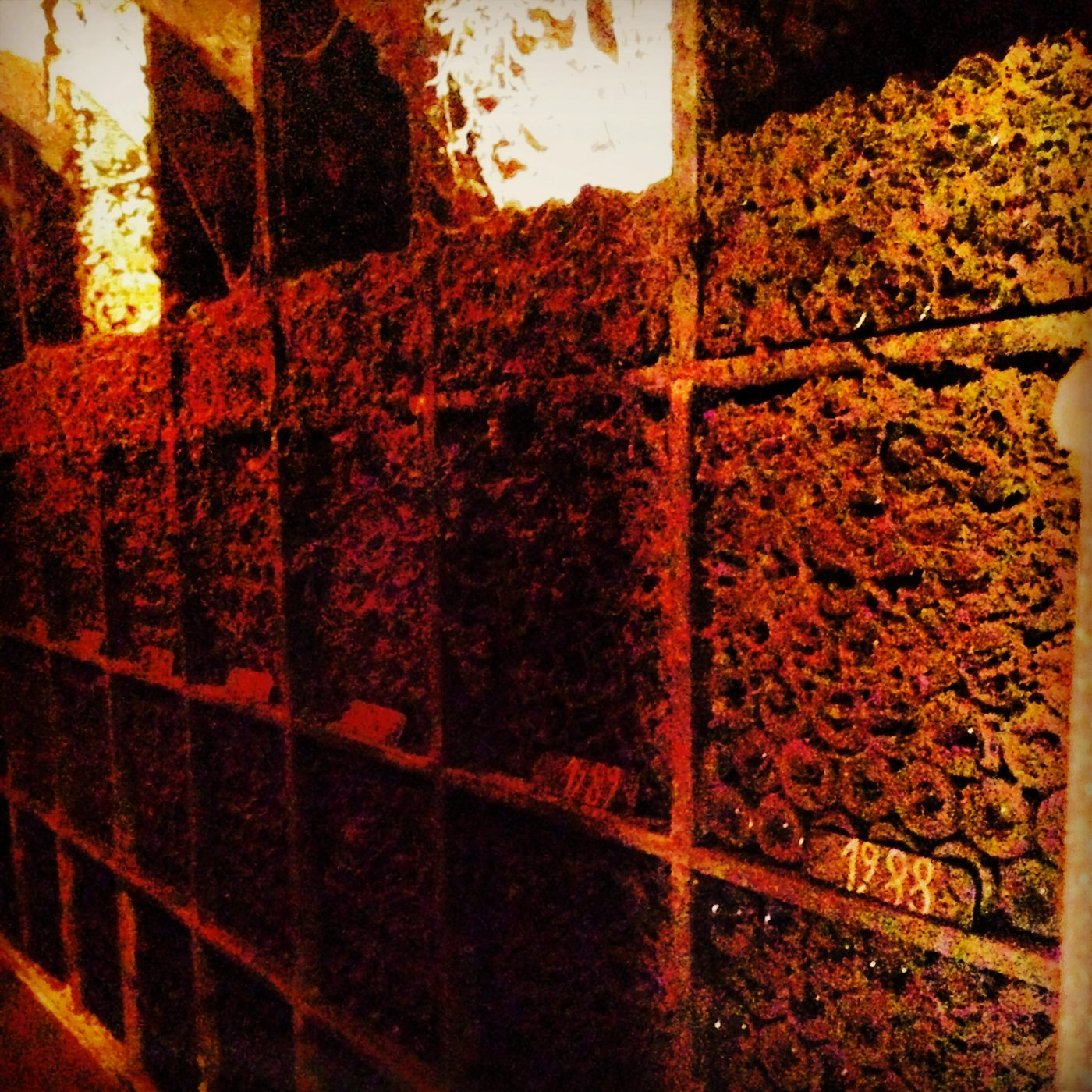
Onward!
Day 3 begins with our car rental. ¡Ay, caramba!
Renting a car in Barcelona begins with actually getting to your rental car agency of your choice. Interesting to say the least.
We had reserved our car online prior to our arrival and had, obviously, done a LOT of research on the situation before arriving. However, there are always additional taxes, insurances, etc that ‘pop up’ in other countries that your reservation does not explain. In the end, we landed a cute little Peugeot that pushes along at 45 miles to the gallon, not bad.
Getting OUT of the city of Barcelona is a whollllleeee other situation. Make sure you have a good gps or a fabulous co-pilot!
Our journey today takes us deeper into the region of Catalonia, specifically to the wine-producing region of Penedès, most famously known for its production of Cava.
Cava, which was once referred to ‘Spanish Champagne’, was renamed after Champagne, France protected the regional name ‘Champagne’ and Spain joined the EU in 1986. ‘Cava’, now the name for Spain’s sparkling wines, and the regions of its production.
With the naming of the appellation, came also stipulations regarding the naming and aging requirements to the region.
Fun Cava Facts:
- The main grapes for production: Macabeo, Parellada, and Xarello, although a number of houses also use some of the more traditional Champagne styled grapes: Pinot Noir & Chardonnay
- Aging requirements for Cava: At the very least, it must spend 9 months in the bottle.
- For a Reserva, the requirement is 15 months and Gran Reserva must spend, at least, 30 months in the bottle before its release
The tiny village of Sant Sadurní d’Anoia (a two hour car drive from Barcelona), which houses the majority of the Cava producers for the region, was our home for the day. With over 100+ producers in the area, the majority houses for Cava production in the region are: Freixenet & Codorníu. Codorníu being the oldest, and Freixenet being the larger producer of the two.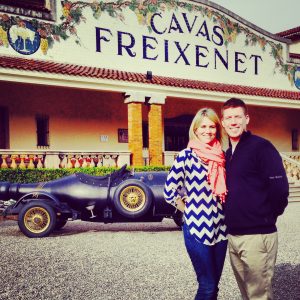
With so much to see and one day to cover it all, our appointments landed us the perfect opportunity to experience not only the BEST of Cava, but distinctly experience the complete opposite ends of the spectrum when it came to the region.
First stop: Segura Viudas & Freixenet ~ Owned and run under one umbrella, the two wineries are really some of the most intensely run properties I have ever seen in the world of wine.
From the underground production facilities and laboratories of Segura to understanding the vast technological advances within the Freixenet house, we walked the entire wine making process from cave to tank to bottle. And, on top of it all – followed the bottling line from one layer to the next within the winery, as we happened upon bottling season!
Freixenet Facts:
- They produce over 85 million bottles of wine a year
- They contract with over 1100 land owners and buy almost all of their fruit for production
- During the harvest season, Freixenet will see upwards of one million kilos of grapes a day for almost 6 weeks.
- Beneath Freixnet’s main building lie almost 25 miles of cellars, reaching up to 6 floors below
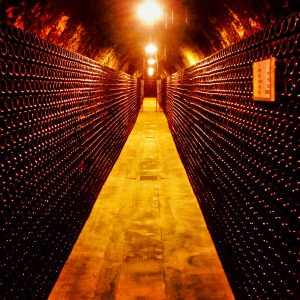 the surface.
the surface. - The majority of their wines in the Freixenet line are produced in the Charmat Method, however, the upper extensions of their portfolios are produced Méthode Champenoise.
- They are responsible for inventing and patenting some of the most advanced equipment in Cava producing history
- Their wines are distributed globally with their main focuses riding primarily on the U.S., the U.K. and Germany
The Wines:
- Both houses produces primarily bubbly, but Freixenet also produces a line of still wines mainly produced for exportation
- While the Freixenet products are nice, the majority of my palate lies on the Segura Viudas side. Famously known for their large production of Brut Reserva, I thoroughly enjoyed the Herdad products from their Gran Reserva side. Having tasted the products many times over in the U.S. – it was a real treat to taste the wines tableside at each winery in a formal tasting setting.
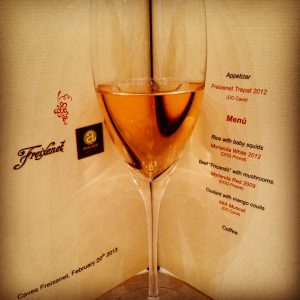 My Favorite: Freixenet Trepat, “Blanc de Noirs”, which uses the authentic grape, Trepat, from the Conca de Barberà. Unbelievably delicious and exceptionally creamy.
My Favorite: Freixenet Trepat, “Blanc de Noirs”, which uses the authentic grape, Trepat, from the Conca de Barberà. Unbelievably delicious and exceptionally creamy.
The wine paired perfectly to our lovely private luncheon amongst Freixenet’s private dining room. Served with local Iberian ham and the traditional crispy Catalan tomato flatbread, Pan de Coca, the wine was a perfect accouterment to our afternoon meal.
And, let us not forget the delicious wines from sister winery located in Priorat, Morlando. The wines, again, a spectacular pairing to the local 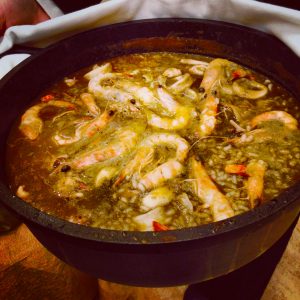 dishes that were served with our luncheon of: Rice with Baby Squids, Shrimp and Clams and Beef Fricandó with mushrooms. YUM!!
dishes that were served with our luncheon of: Rice with Baby Squids, Shrimp and Clams and Beef Fricandó with mushrooms. YUM!!
Our tour guide for the day, from the hospitality staff of the 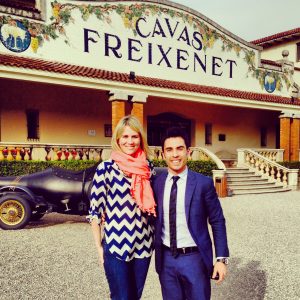 wineries, Señor Xavier Flores was an exquisite and exceptionally generous host!
wineries, Señor Xavier Flores was an exquisite and exceptionally generous host!
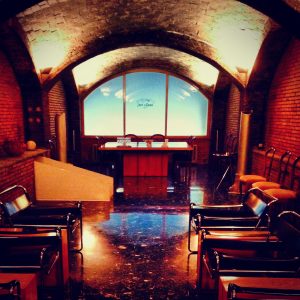 As if the day was not already perfect, we went from the grand hospitality of Freixenet on to the luxury brand tasting of small family owned Cava house: Juvé y Camps
As if the day was not already perfect, we went from the grand hospitality of Freixenet on to the luxury brand tasting of small family owned Cava house: Juvé y Camps
Greeted by the sensationally hospitable, Señor Oriol Gual, our very quiet and casual visit to the family owned winery, was a lovely way to end our day after a very busy day of cave touring.
From the enormous caves of Freixenet and Segura Viudas to the adorably quaint caves of Juvé y Camps, we went from experiencing a bottling line corking upwards of 1,000 bts per minute to a 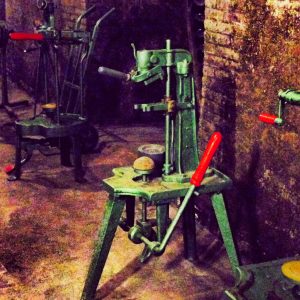 small 125yr old hand corking machine in the corner, used for all of the wineries large formatted bottles. A single line of bottling, which moved from one layer of the winery to the next, was responsible for the majority of the winery’s single 750mL bottlings.
small 125yr old hand corking machine in the corner, used for all of the wineries large formatted bottles. A single line of bottling, which moved from one layer of the winery to the next, was responsible for the majority of the winery’s single 750mL bottlings.
Juvé y Camp Facts:
- Responsible for production of almost 3 million bottles. Just a mere slice of the larger houses in the region.
- Juvé y Camps leads the Cava industry in the ‘Premium Market’ sector
- The winery has worked within the last 5 years to turn over completely and certify ‘organic’ and will be releasing their first ‘organics’ within the next year to the market
- Almost all of the winery’s Cavas are Gran Reservas (aged 30+ months)
- The winery only produces under Méthode Champenoise
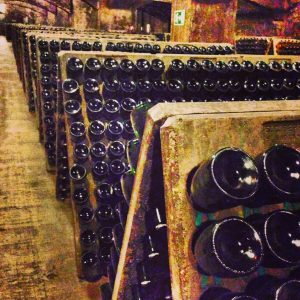
- The winery only produces wines from the first press of juice of their Cava grapes, called the ‘free run’ juice
- The winery owns almost all of the Cava grapes they use for production
The Wines:
- While the primary production of Juvé y Camps is Cava, they offer a splendid bottling of crisp, floral, refreshing whites made from a variety of grapes from the
 region: Malvesia, Muscat and Gewurztraminer. Stunning!
region: Malvesia, Muscat and Gewurztraminer. Stunning!
My Favorites:
- There were just too many too pick. One after another pleased the palate with crisp acidity, low dosage and freshly intriguing notes of florals, spice, ripe fruit and chalky minerality.
- Yet, if I had to pick one – I’d say the winery’s Blanc de Noirs, made from 95% Pinot Noir and 5% Xarello, was my pick of the day. Loaded with brite notes of yellow raspberries, lush rose petal and fresh strawberry, my palate landed the sensory overload with the rush of flavors from this wine.
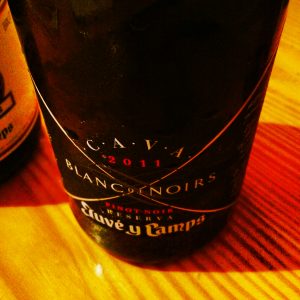
In the end, Penedés was a magical place! From one of the spectrum to the other, it was not only a treat, but an honor to have spent time with both wineries. From literally, two of the most hospitable visits I’ve experienced abroad, I will be honored to raise both the flags of the Freixenet family wineries and Juvé y Camps.
Note: There are only TWO hotels in Sant Sadurní d’Anoia, one inside the city limits and the only just 2 miles outside of. After a long day of drinking Cava, I’d recommend our pick: Hotel Fonda Neus. Spendy at $125 a night, but ridiculously clean, hospitable and easy to find! Ask for the owner, Peter, a real gem and an entirely gracious host.